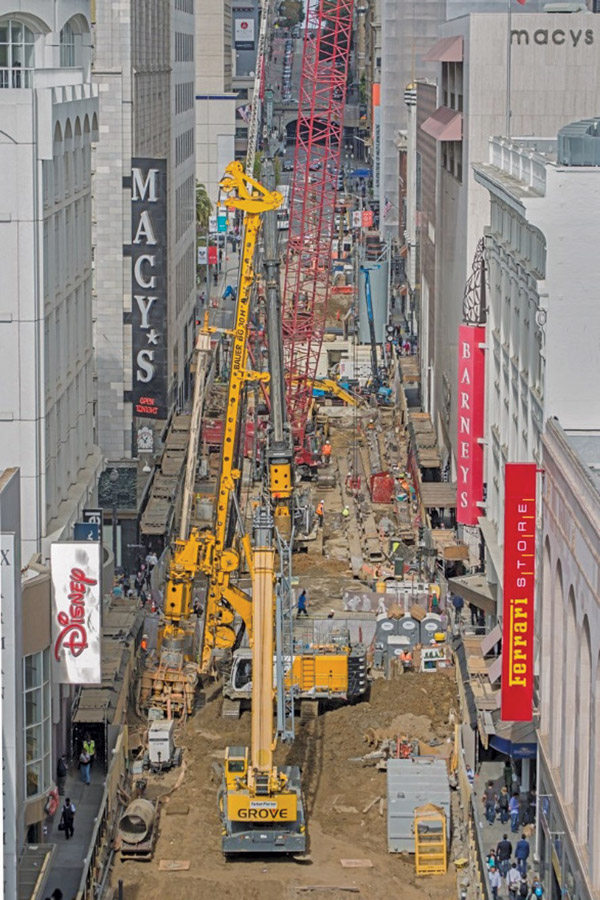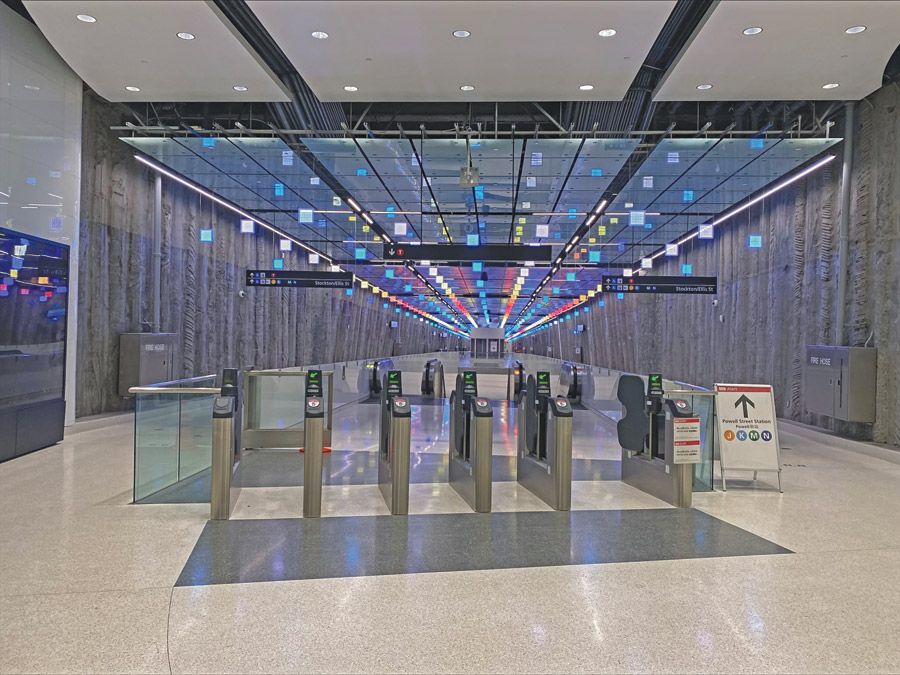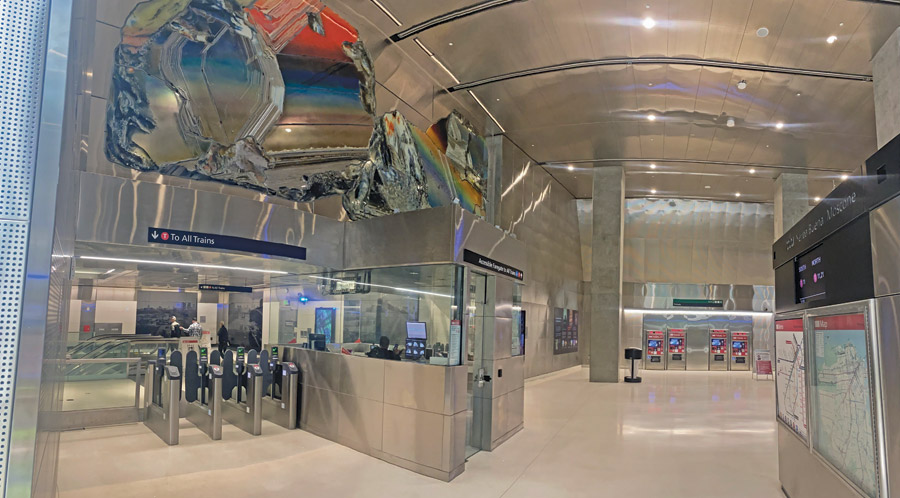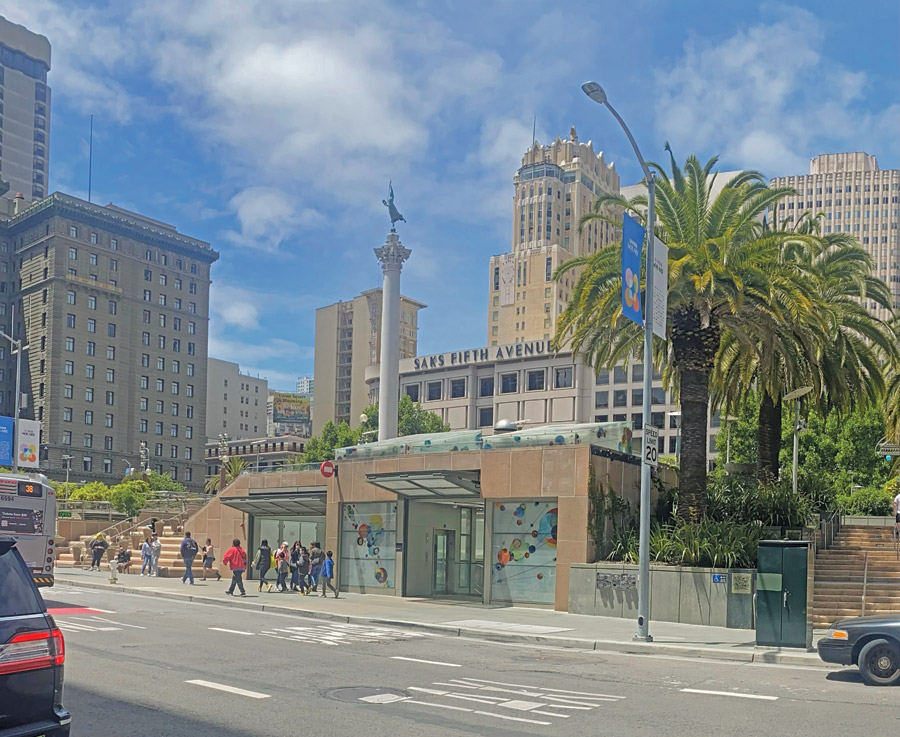SFMTA Central Subway Underground Stations
San Francisco
BEST PROJECT, AIRPORT/TRANSIT
KEY PLAYERS
Submitted by: WSP USA
Owner: San Francisco Municipal Transportation Agency
Designer: Central Subway Design Group JV
Prime Contractor: Tutor Perini Corp.
San Francisco’s Chinatown is the most densely populated neighborhood in the city, but a streetcar route that helped spur the area’s growth during the first half of the 20th century shut down in 1951. That left the area underserved by public transit for decades, says Zylah Doria, project manager at WSP USA.
Earlier this year, a new subway line extension opened, retracing a route similar to that of the defunct streetcars. It carries the San Francisco Municipal Transportation Agency’s (SFMTA) 5.6-mile at-grade Muni Metro T Third Line another 1.7 miles north through the central neighborhoods South of Market, Union Square and Chinatown.
“It’s great for the community,” Doria says. “Providing equity for these communities is really important, and it’s a good thing for the city.”
The Central Subway Project included construction of four stations along the new section of track, three of which are underground. Construction of the $1.9-billion project lasted more than a decade, after preliminary engineering work that started in 2003. The idea for the line has been around even longer, with county officials identifying it as a transportation corridor in need of improvement as early as the 1980s. That need was prioritized after the 1989 Loma Prieta earthquake, which exposed weaknesses of local infrastructure.
The area served by the extension has continued to grow since then, and the project team faced unique challenges at each of the three underground stations from the busy area’s existing buildings, perpendicular subway lines and subsurface conditions. For different sections of the project, the project team used a mix of cut-and-cover, sequential excavation methods and tunnel-boring machines.
“We had to work around tourists, shoppers,” says Sangmin Kim, who served as an engineer and PM on the project team for WSP. “It’s a very busy part of the city, and it required a lot of coordination.”
WSP is the lead partner of Central Subway Design Group, the joint venture that designed the three underground stations. WSP partnered with DLR Group and MWA Architects on the design work. They used a separate designer for each of the three stations, but SFMTA assembled all the design resources under one roof, says Matt Fowler, who worked on the project’s preliminary designs and was WSP’s project manager for both utility relocations and the tunnel design. That decision was “instrumental” in making the project a success, he adds.
“The office setting was very collaborative, and I think that contributed a lot to the project,” Fowler says.

The team drilled hundreds of piles at an incline to form the east and west walls of Union Square/Market Street Station, where the platform level is wider than the surface right-of-way.
Photo courtesy SFMTA
Crowded Location
“If we had any cracks or settlement—can you imagine? The Muni trains would’ve had to shut down.”
—Nadeem Tahir, Project Director, SFMTA
The first and southernmost of the underground stations is Yerba Buena/Moscone (YBM) Station, located near the George R. Moscone Convention Center. Its 60 ft depth was necessitated by the tiebacks of surrounding buildings.
The crowded surroundings also required YBM to have the smallest footprint of the new stations. Rather than using an initial support and then building a final lining inside of it, Fowler says the team opted to use slurry walls as both initial and final support because of the limited right-of-way.
The team also used a top-down construction method in order to allow traffic to return to busy Fourth Street as soon as possible while construction continued with off-street access, Fowler says. Overall, he says YBM is the most traditional of the stations.
“Each of those stations was tailor-made to its geology and its setting,” Fowler says.

"Lucy in the Sky" at Union Square/Market Street Station, made of LED panels, is one of the art pieces that make each station unique.
Photo courtesy Central Subway Team
Perpendicular Tunnels
Union Square/Market Street (UMS) Station is next along the line. It sits even deeper than YBM, 80 ft underground, because nearby the line crosses below existing Muni and Bay Area Rapid Transit (BART) tunnels.
“That was one of the bigger challenges that we faced,” Fowler says. “It required a lot of coordination with BART to prove to them that we can tunnel directly beneath their tunnels.”
Nadeem Tahir, SFMTA’s director for the project, credits the contractors for maintaining the correct tunnel alignment when boring so close to the existing tunnels.
“If we had any cracks or settlement—can you imagine? The Muni trains would’ve had to shut down, and the BART system would have ground to a halt because every line goes into Market Street,” he says.
“We were mindful of each neighborhood and the demands, wants and needs of each separate community.”
—Zylah Doria, Project Manager, WSP USA
The designers also turned to an unusual strategy to balance the narrow right-of-way at the street level with the greater required width for the trains at the platform level. They relocated utilities into joint trenches under the sidewalks and used inclined tangent piles in order to achieve the needed width.
They believe this was the first use of inclined tangent piles like this in the U.S. Fowler says they looked for precedent around the world and found a station in Germany that also used inclined piles. But Kim notes the German example was built in rock or more competent soil, while UMS was built in soft soil. They used jet grouting between the piles to make it watertight.
Similar to YBM, the battered drilled piles were used as both initial and permanent ground support for the station.
Kim says the contractors, led by Tutor Perini Corp., came up with the idea to use pilot holes—similar to the technique a carpenter uses to drill holes at an angle—in order to achieve the needed verticality for the piles.
The two-block-long station required hundreds of 4-ft-dia piles that had to be drilled 125 ft into the ground, according to Doriah.
“It was a pretty massive undertaking,” she says.
Kim says they had a “robust” program to protect buildings around the station alignments, using techniques such as compensation grouting.
“We monitored all the movement of the buildings,” Kim says. “The client met with all those neighbors prior to construction and gave them a good understanding of what we were going to do.”

The project team worked with the San Francisco Arts Commission to meet a city mandate to support artists, helping make each station distinct.
Photo courtesy SFMTA
Geologic Variance
Chinatown-Rose Pak Station (CTS) is named after a local activist who Tahir says was instrumental in bringing the station to the neighborhood. Pak, who died in 2016, helped build support in the community that continued through the approval process.
“She was one of the champions of getting this project to Chinatown,” Tahir says.
When initial geotechnical investigations probed the CTS site, they discovered deeper soil-rock contact than expected, Fowler says. So the station had to be built 120 ft below grade to account for the undulating geologic profile and underlying bedrock.
SFMTA had also committed to minimize the disruption on Stockton Street, which is home to many businesses and used for three major bus routes. To meet that commitment, the team used cut-and-cover construction for just the station headhouse and opted to use a sequential excavation method to mine out the station cavern via an off-street shaft.
“It’s complicated construction, and it takes longer, Tahir says. “It’s more risky and also more expensive, but we had to do that. And even then we had a considerable impact on the community.”
The team worked methodically to only excavate as much ground as they could quickly support in order to limit surface settlements, Fowler says. From the headhouse, crews mined a cross-cut through to the tunnels, which had already been bored. Turning about 90 degrees north and south, they mined out the 55-ft-wide station platform cavern and a crossover cavern beyond it. Finally, they mined all the access, vertical circulation and back-of-house spaces for the station.

The north station entrance integrates with busy Union Square. A glass art installation welcomes riders.
Photo courtesy SFMTA
Reflecting the Community
It wasn’t just the different geological conditions of each station that sets them apart from one another. Doria says the team worked with local architects who were sensitive to the concerns of residents in each neighborhood—as well as the San Francisco Arts Commission—to create stations that reflected their respective communities.
For example, the arts commission helped the team select a 102-ft-tall sculpture for the plaza level at YBM to act as a monument for visitors at the nearby convention center. UMS features an installation of lit panels running the length of the concourse ceiling and a 250-ft-long stainless steel sculpture over the platform. At CTS, they brought in a pair of large laser-cut metal panels in the style of traditional papercuts by local artist Yumei Hou for the concourse and mezzanine levels.
“They’re not just cookie cutter, copy/paste stations,” Doria says. “We were very mindful of each neighborhood and the demands, wants and needs of each separate community.”
The team also added an open-air plaza to the roof of CTS at the request of the Chinatown Community Development Center. Tahir says it required revisions in the structural design, but the final result is popular with locals. SFMTA recently held a swearing-in ceremony for a new board member at the plaza, and Doria says it’s seeing use for various events as well as by people who just want to eat lunch outside on sunny days.
“It’s nice to see the community using it,” she says.
SFMTA met with local business owners weekly to advise them of upcoming impacts from the work and hired ambassadors to share news in the community, Tahir says. They also halted work around the lunar new year to avoid disturbing celebrations in Chinatown.
Muni ridership overall has not recovered to pre-COVID-19 levels, but Tahir says numbers from the Chinatown station in particular have been positive. Fowler says he’s seen the train busy while riding it himself.
“It’s heartening for me to ride it and see all the people riding from Union Square up to Chinatown,” he says. “Some mornings it’s standing room only.”




